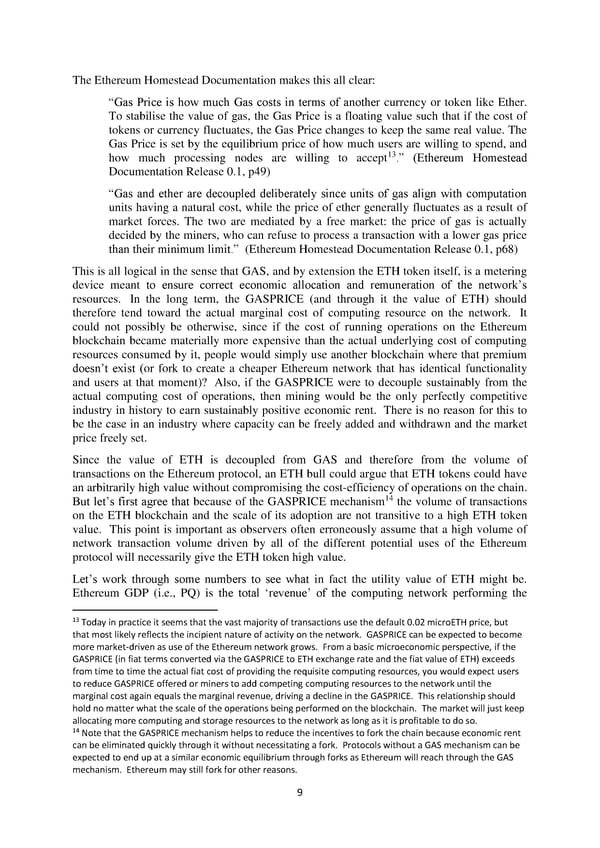The Ethereum Homestead Documentation makes this all clear: “Gas Price is how much Gas costs in terms of another currency or token like Ether. To stabilise the value of gas, the Gas Price is a floating value such that if the cost of tokens or currency fluctuates, the Gas Price changes to keep the same real value. The Gas Price is set by the equilibrium price of how much users are willing to spend, and how much processing nodes are willing to accept13.” (Ethereum Homestead Documentation Release 0.1, p49) “Gas and ether are decoupled deliberately since units of gas align with computation units having a natural cost, while the price of ether generally fluctuates as a result of market forces. The two are mediated by a free market: the price of gas is actually decided by the miners, who can refuse to process a transaction with a lower gas price than their minimum limit.” (Ethereum Homestead Documentation Release 0.1, p68) This is all logical in the sense that GAS, and by extension the ETH token itself, is a metering device meant to ensure correct economic allocation and remuneration of the network’s resources. In the long term, the GASPRICE (and through it the value of ETH) should therefore tend toward the actual marginal cost of computing resource on the network. It could not possibly be otherwise, since if the cost of running operations on the Ethereum blockchain became materially more expensive than the actual underlying cost of computing resources consumed by it, people would simply use another blockchain where that premium doesn’t exist (or fork to create a cheaper Ethereum network that has identical functionality and users at that moment)? Also, if the GASPRICE were to decouple sustainably from the actual computing cost of operations, then mining would be the only perfectly competitive industry in history to earn sustainably positive economic rent. There is no reason for this to be the case in an industry where capacity can be freely added and withdrawn and the market price freely set. Since the value of ETH is decoupled from GAS and therefore from the volume of transactions on the Ethereum protocol, an ETH bull could argue that ETH tokens could have an arbitrarily high value without compromising the cost-efficiency of operations on the chain. But let’s first agree that because of the GASPRICE mechanism14 the volume of transactions on the ETH blockchain and the scale of its adoption are not transitive to a high ETH token value. This point is important as observers often erroneously assume that a high volume of network transaction volume driven by all of the different potential uses of the Ethereum protocol will necessarily give the ETH token high value. Let’s work through some numbers to see what in fact the utility value of ETH might be. Ethereum GDP (i.e., PQ) is the total ‘revenue’ of the computing network performing the 13 Today in practice it seems that the vast majority of transactions use the default 0.02 microETH price, but that most likely reflects the incipient nature of activity on the network. GASPRICE can be expected to become more market-driven as use of the Ethereum network grows. From a basic microeconomic perspective, if the GASPRICE (in fiat terms converted via the GASPRICE to ETH exchange rate and the fiat value of ETH) exceeds from time to time the actual fiat cost of providing the requisite computing resources, you would expect users to reduce GASPRICE offered or miners to add competing computing resources to the network until the marginal cost again equals the marginal revenue, driving a decline in the GASPRICE. This relationship should hold no matter what the scale of the operations being performed on the blockchain. The market will just keep allocating more computing and storage resources to the network as long as it is profitable to do so. 14 Note that the GASPRICE mechanism helps to reduce the incentives to fork the chain because economic rent can be eliminated quickly through it without necessitating a fork. Protocols without a GAS mechanism can be expected to end up at a similar economic equilibrium through forks as Ethereum will reach through the GAS mechanism. Ethereum may still fork for other reasons. 9
 Investor’s Take on Cryptoassets by John Pfeffer Page 8 Page 10
Investor’s Take on Cryptoassets by John Pfeffer Page 8 Page 10